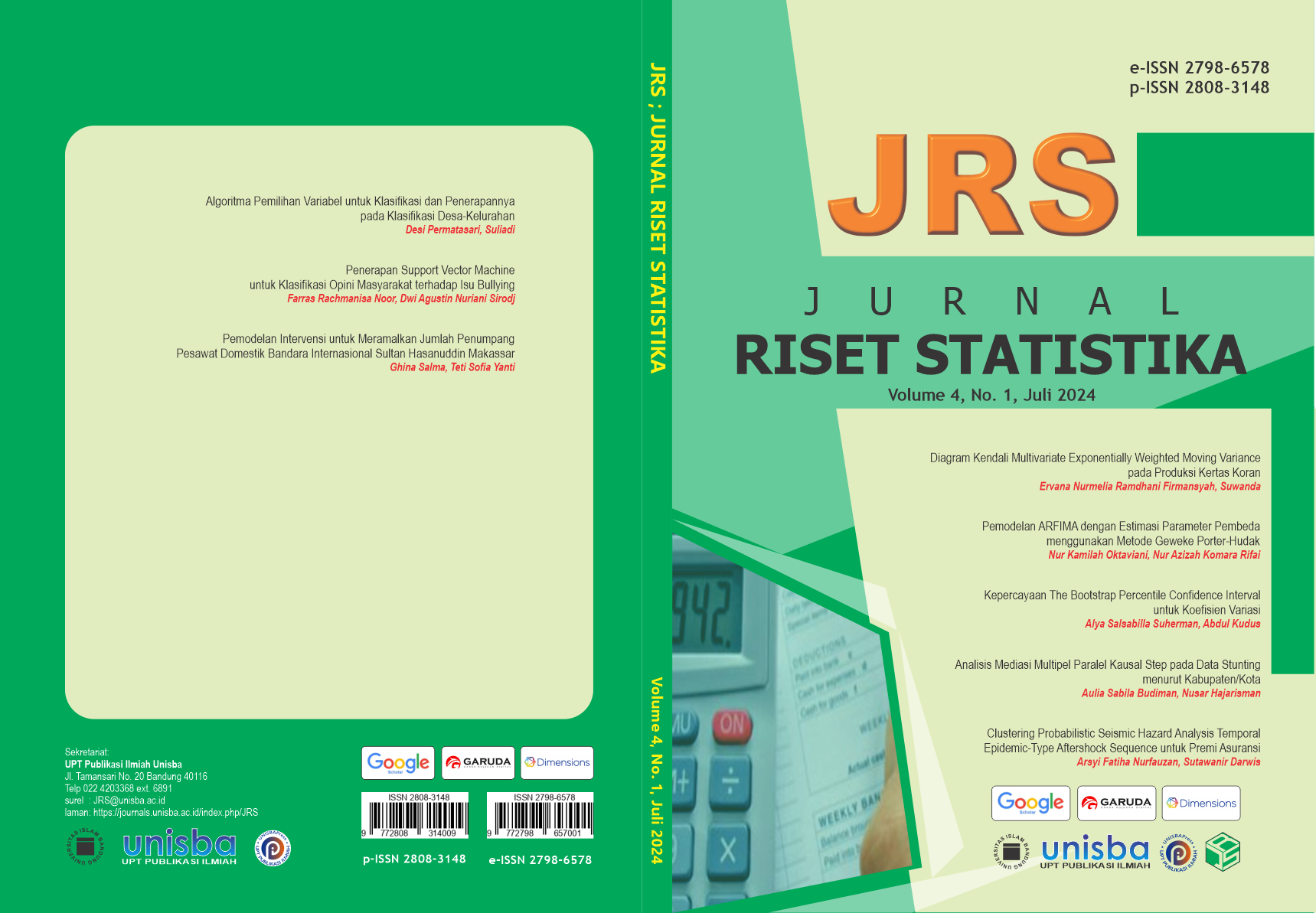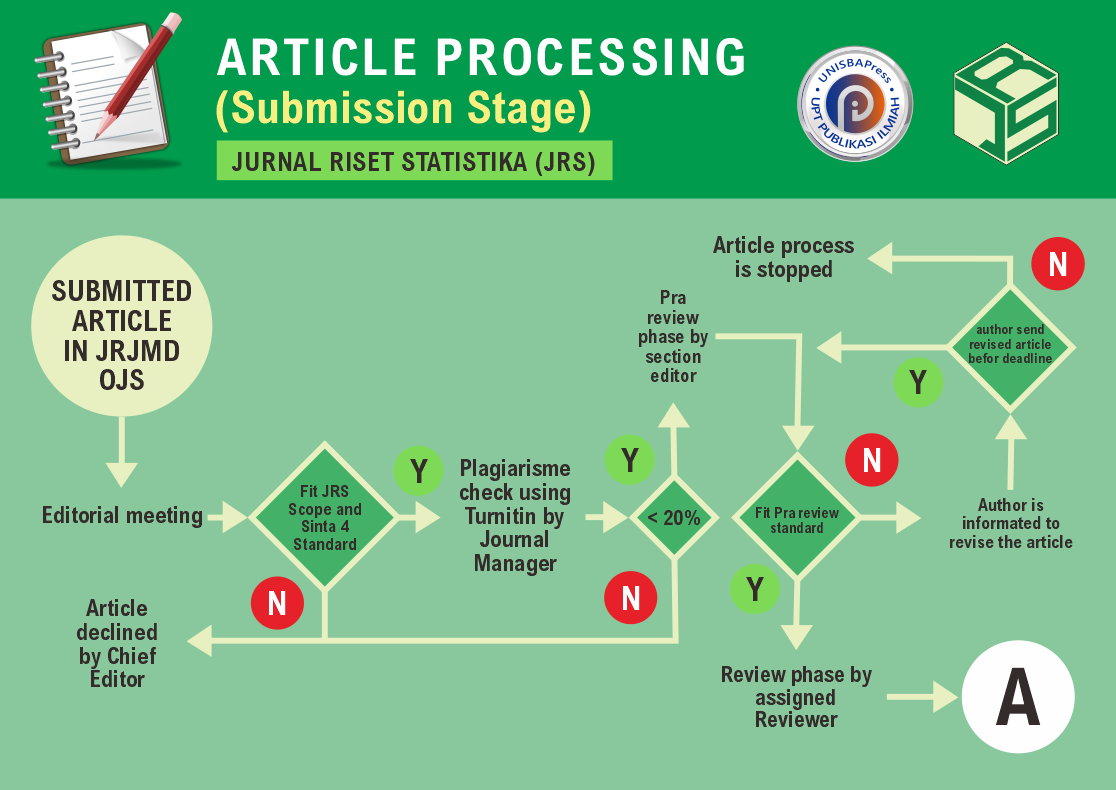Pemodelan Intervensi untuk Meramalkan Jumlah Penumpang Pesawat Domestik Bandara Internasional Sultan Hasanuddin Makassar
DOI:
https://doi.org/10.29313/jrs.v4i1.3892Keywords:
Seasonal Autoregressive Integrated Moving Average (SARIMA), Intervensi, Covid-19Abstract
Abstract. SARIMA is a time series method designed for data with seasonal components, assuming stationarity. When data is non-stationary due to shocks, it may involve interventions. In March 2020, the first case of Covid-19 was detected in Indonesia, causing data to contain interventions due to a sharp decline in data patterns. Intervention events occurred because the Indonesian government implemented the Large-Scale Social Restrictions policy to control the virus's spread and protect public health, involving various aspects, including restricting air transportation. The purpose of this research is to determine the appropriate model between SARIMA and Intervention, evaluated based on the Akaike Information Criterion (AIC). The data used is the actual number of domestic flight passengers departing from Sultan Hasanuddin Airport. From the testing results of both methods, the SARIMA model obtained is ARIMA (1, 1, 0)(0, 1, 0)12 with an AIC value of 1.673, while the Intervention model is ARIMA (1, 1, 0)(0, 1, 0)12, b = 0, s = 5, and r = 1 with an AIC value of 1.662. Thus, the intervention method is better suited for forecasting the number of domestic flight passengers at Sultan Hasanuddin Airport due to its lower AIC value.
Abstrak. SARIMA adalah data deret waktu yang mengandung unsur musiman dengan asumsi yang harus dipenuhi yaitu asumsi stasioneritas. Ketika data tidak stasioner karena adanya shock pada data, maka data tersebut mengandung intervensi. Pada bulan Maret 2020, kasus Covid-19 pertama kali terdeteksi di Indonesia yang menyebabkan data mengandung intervensi karena pola data mengalami penurunan yang sangat tajam. Kejadian intervensi terjadi karena Pemerintah Indonesia mengeluarkan kebijakan terhadap PPKM yang diterapkan untuk mengendalikan penyebaran virus dan melindungi kesehatan masyarakat, yang melibatkan berbagai aspek salah satunya membatasi perjalanan transportasi udara. Tujuan penelitian ini adalah mengetahui model yang tepat antara SARIMA dan Intervensi yang dihitung berdasarkan Akaike Information Criterion (AIC). Data yang digunakan yaitu data aktual jumlah penumpang pesawat domestik yang berangkat dari Bandara Sultan Hasanuddin. Dari hasil pengujian kedua metode, diperoleh model SARIMA yaitu ARIMA (1, 1, 0)(0, 1, 0)12 dengan nilai AIC sebesar 1.673, sedangkan model intervensi yaitu ARIMA (1, 1, 0)(0, 1, 0)12, b = 0, s = 5, dan r = 1 dengan nilai AIC sebesar 1.662. Sehingga metode intervensi lebih baik digunakan untuk meramalkan jumlah penumpang pesawat domestik di Bandara Sultan Hasanuddin karena memiliki nilai AIC yang lebih kecil.
References
S. Makridakis, S. C. Wheelwright, and V. E. McGee, Metode dan Aplikasi Peramalan, 3rd Ed. Jakarta: Erlangga, 1998.
P. J. Brockwell and R. A. Davis, An Introduction to Time Series and Forecasting. New York: Springer, 1996.
C. Chatfield, C. M. Douglas, and K. Murat, Introduction to Time Series Analysis and Forecasting. New Jersey (US): John Wiley & Sons, 2008.
D. H. James, Time Series Analysis. New Jersey: Princeton University Press, 1994.
A. Iswari, Y. Angraini, and M. Masjkur, “Comparison of The SARIMA Model and Intervention in Forecasting The Number of Domestic Passengers at Soekarno-Hatta International Airport,” Indonesian Journal of Statistics and Its Applications, vol. 6, no. 1, pp. 132–146, May 2022, doi: 10.29244/ijsa.v6i1p132-146.
B. Juanda and Junaidi, Ekonometrika Deret Waktu Teori & Aplikasi. Bogor: IPB Press, 2012.
J. Armstrong, Long-Range Forecasting, 2nd Ed. New York: John Wiley & Sons, 1985.
G. Vincent, Statistika untuk Fakultas Ekonomi dan Fakultas Ilmu-Ilmu Sosial. Bandung: Armico, 1989.
W. Enders, Applied Econometric Time Series. New York: John Wiley & Sons, 1995.
S. Pratiwi and M. Herlina, “Pengaruh Harga Pangan terhadap Inflasi dengan Metode Vector Autoregressive Integrated Moving Average,” Jurnal Riset Statistika, vol. 3, no. 2, pp. 87–96, Dec. 2023, doi: 10.29313/jrs.v3i2.2690.
M. Spyros and H. Michele, “ARMA Models and the Box-Jenkins Methodology,” J Forecast, vol. 16, pp. 147–163, 1997.
W. W. S. Wei, Time Series Analysis: Univariate and Multivariate Methods, 2nd Ed. New Jersey: Pearson Prentice Hall, 2006.
A. Pankratz, Forecasting with Dynamic Regression Models. New York: John Wiley & Sons, 1991.
U. N. Fazrilillah and O. Rohaeni, “Penerapan Metode Holt’s Exponential Smoothing Dalam Memprediksi Jumlah Nasabah Kredit,” DataMath: Journal of Statistics and Mathematics, vol. 2, no. 1, pp. 11–16, 2024.













